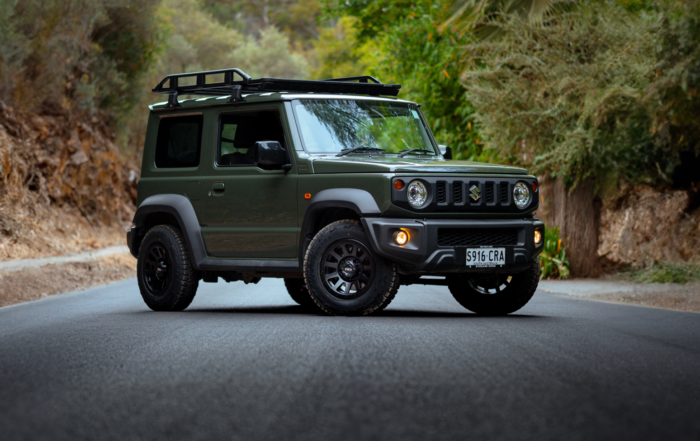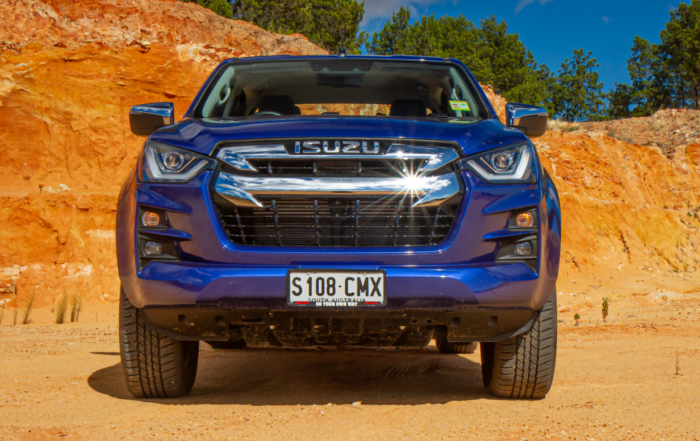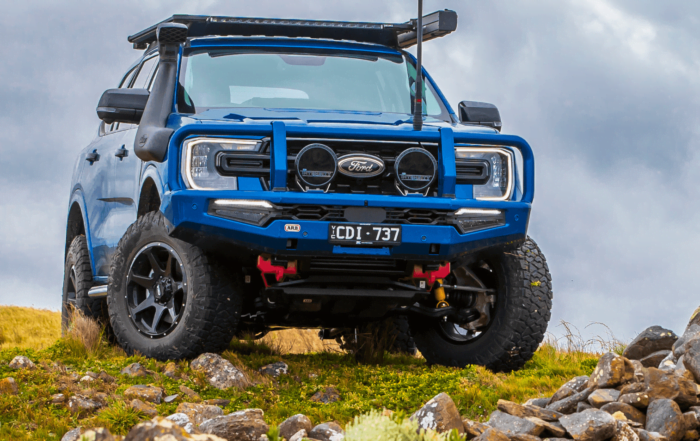2021 Suzuki Jimny Review
2021 Suzuki Jimny Review
You know, there are precious-few 4WDs that I’ll acknowledge as I’m driving around. It’s a sea of blandness. All the Thai-built Japanese 4WD wagons are going down the same path of ever-increasing ugliness, their makers trying to outdo one another in making snazzy angular LED headlight/DRL treatments, others are just dumbing theirs down to meet the expectations of the urban ninety-percenters. It’s enough to drive a bloke to drink.
However one manufacturer has poked a stick in the eye of the “Transformer” stylists and gone back to its roots and builds a compact wagon that I reckon is just the duck’s guts. It’s not perfect, but every time I see one I’ll pay attention.
It’s the Suzuki Jimny.
I reckon it was a ballsy move, when whoever the brave Suzuki executive who proposed a Kermit-green square box on wheels, should be the next-gen JB74 Jimny and succeeded in convincing a board of directors that it would sell. Sell it has. Like hotcakes infused with something illicit. The “drugs” that Jimny brings to the table are styling cues that scream sensible, basically two boxes, and a capability that all the pretenders can’t match.
Let’s talk about those boxes.

The shape is perfect for a 4WD. Those slab sides equate to internal volume, with an absence of tapering roof lines to impinge on carrying capacity internally; incredibly important when it’s a micro-4WD. Helping maximise useable space is a rear folding seat arrangement that’ll lay flat. I had a look at the mounting system for the back seats, and it wouldn’t take much to remove them and increase the depth of the cargo area even more if the seat/seatbelt sensors could be unplugged.
I found the driving position to be spot on, the seat base height okay and fore/aft movement enough to offer my six-foot frame a very comfy reach to the pedals and the steering wheel. The steering wheel is adjustable, so if you’re carrying a bit of belly, you’ll still be able to sneak it in under the wheel’s rim. The seats were comfortable with decent support, and my bum remained numb-free after three hours.
Two big blokes would be touching shoulders in the old Jimny’s cab. This one’s noticeably wider, but I reckon there’s a market for one a little larger again and with four doors for a better payload.
The new two-door Jimny measures 3,645mm long and 1,645mm wide, which is compact. Combine that small footprint with the excellent visibility afforded by the Jimny’s squared off corners and upright windscreen, and you have the perfect ‘around town’ vehicle.
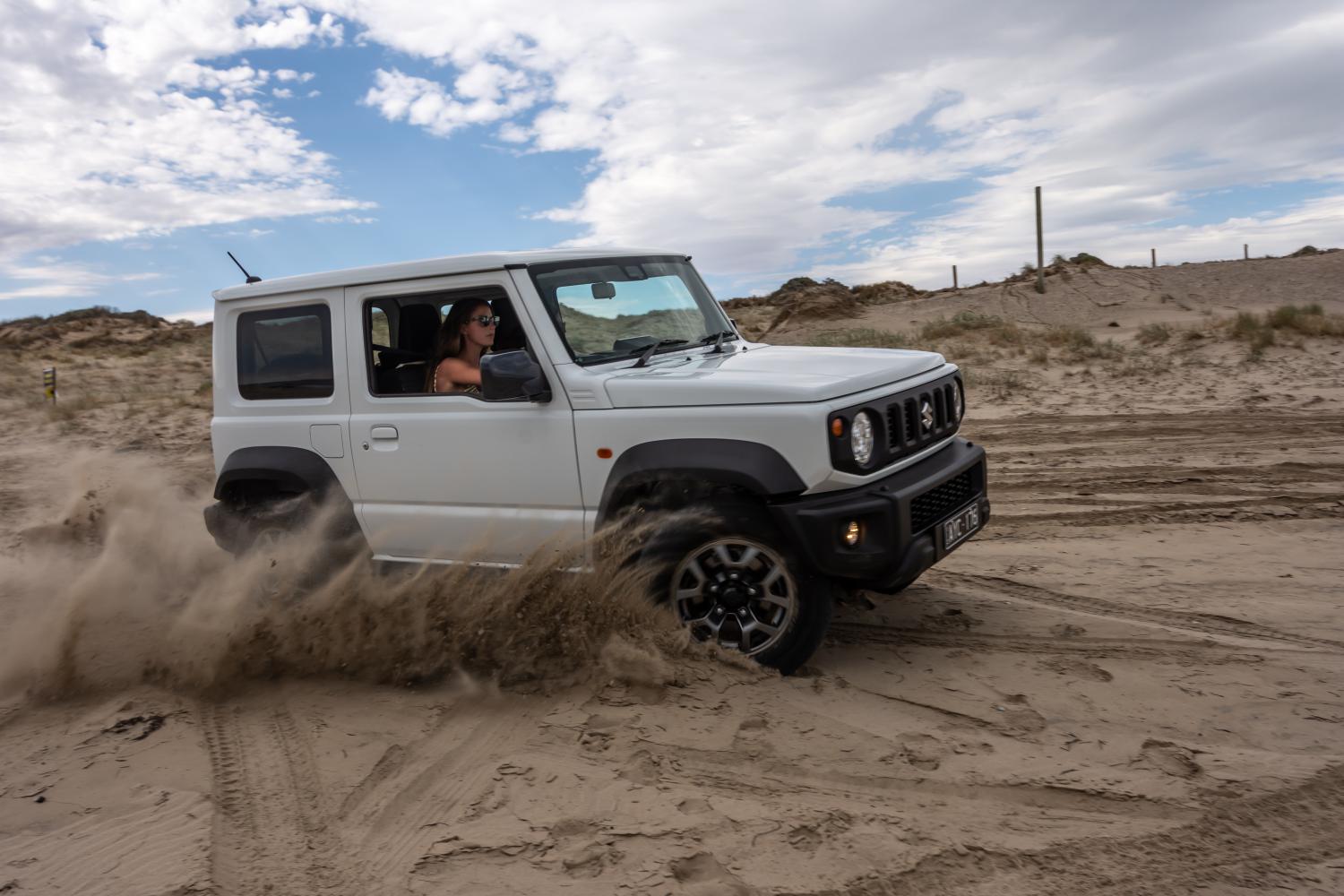
Throwbacks to days of old are everywhere. It has a key, not one of those idiotic push-button starts with a dopey transponder to go wrong. I love the fact that it has roof gutters and not the flimsy plastic roof rails seen on the old model. That will make a roof-rack an easy-peasy install. It’s also got round, yes round, LED headlights and they work, because the lens isn’t some funky angular thing, they have a nice deep reflector that projects a beam down the road. What I didn’t like so much, was the oncoming or ambient light sensor that made switching to high beam impossible around town even when there was nobody around.
While the Jimny remains true to its roots, it’s now packing a larger electronic arsenal and several concessions to modernity.
Right slap bang in the middle of the dash is a telly. Jimny has joined the touch screen infotainment revolution, and this one is a pretty good thing with hook-ups to Apple CarPlay and Android Auto via a USB outlet. Bluetooth was quick to capture my phone and get me chatting, or you can plug your phone in via a USB outlet and use The sound was fine for my analogue ears on the AM stations and Georgia our resident ‘bright young thing’ (BYT) and road tester thought the sound was good enough to satisfy most people’s curiosity. There’s a couple of 12V outlets, and the reversing camera was clear and easy to use.
Electric windows and mirrors you’ll find, and an air conditioning system, that despite the glasshouse effect of the cab, managed to deal with a couple of stinking hot Adelaide days.
The interior is carpeted and likes to trap sand, making the clean-up a frustrating exercise. I’d like to see vinyl in there, but hey, it’d likely be fixed with some decent rubber mats. The carpet mats sitting atop the carpeted floor will cop a hammering, so my advice would be to seek out some aftermarket sculpted rubber versions and do it early in your ownership, because old carpet looks like shite.
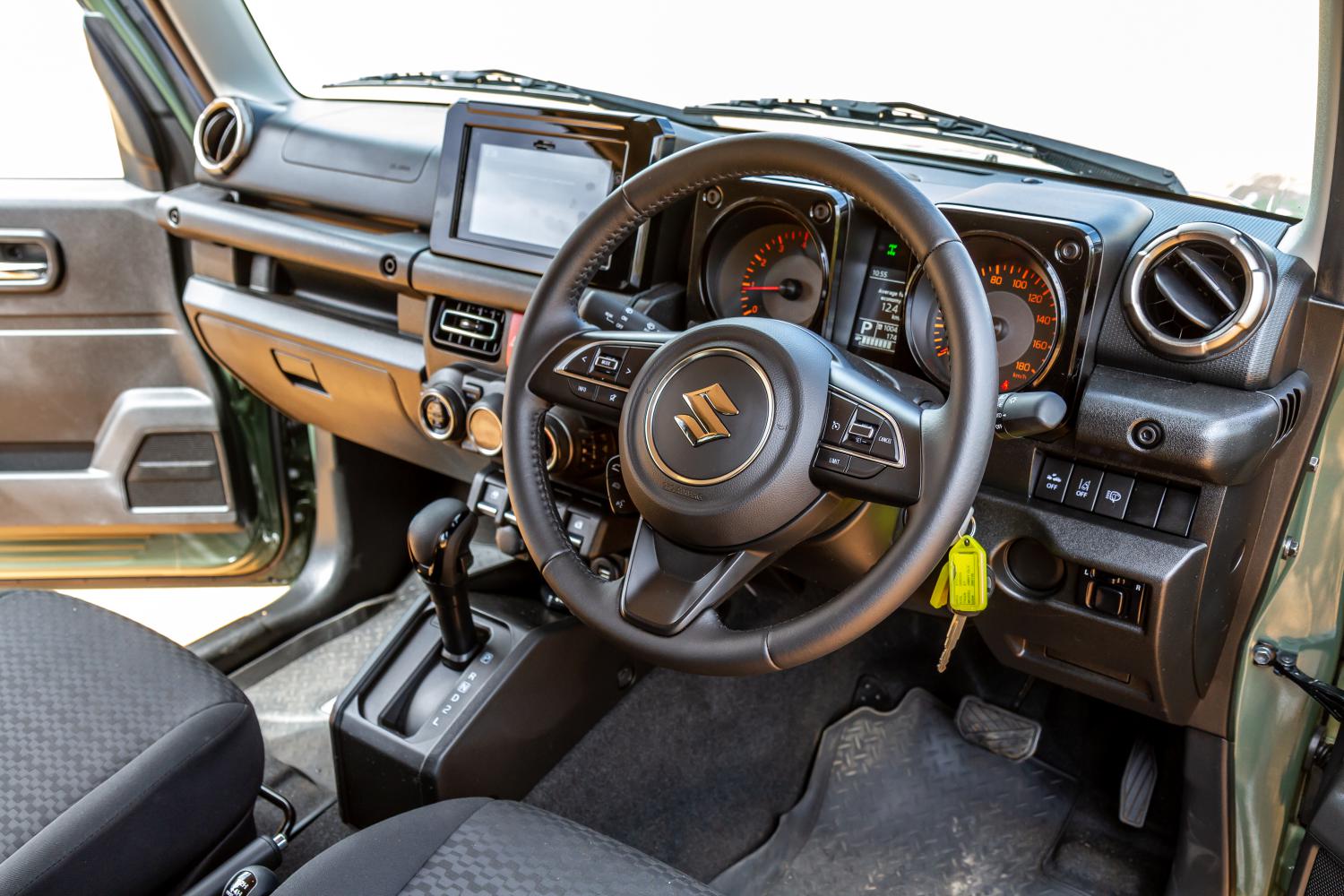
Additionally, the plastic surfaces, dash, door cards and rear seat backs are a hard composition and will scratch easily. For the sake of my old right elbow, a door card with a hint of forgiveness would have been nice for windowsill resting, and the left one is left dangling as there’s no centre console cubby-box, merely a couple of drink holders set low behind the handbrake.
Below the central air vents and A/C controls are the buttons for some of the selectable driver aids and safety kit now standard in Jimny, including traction/vehicle stability control (TRC/VSC) and hill descent control (HDC). Suzuki calls its traction control system ‘Brake LSD’, which is a curious description because it bears no resemblance to a slippery diff in the way it works.
It’s even got lane departure (LDW), lane weave (LW) and forward autonomous braking (FAB) hooked up to anti-lock brakes (ABS) and hill-hold (HH), all of which is a serious departure from what was found in previous Jimnys.
Despite my indignation at these concessions to modernity, I’ll have to pull my safety hat on a little tighter, as they’re necessary, not only to move with the times but also to mitigate the new Jimny’s on-road flaw, which is safety at speed. Suzuki’s solid axle Jimny isn’t as safe at high speed as vehicles with independent suspension, either up-front or all round. It’s one of the reasons most manufacturers have moved away from this type of suspension.
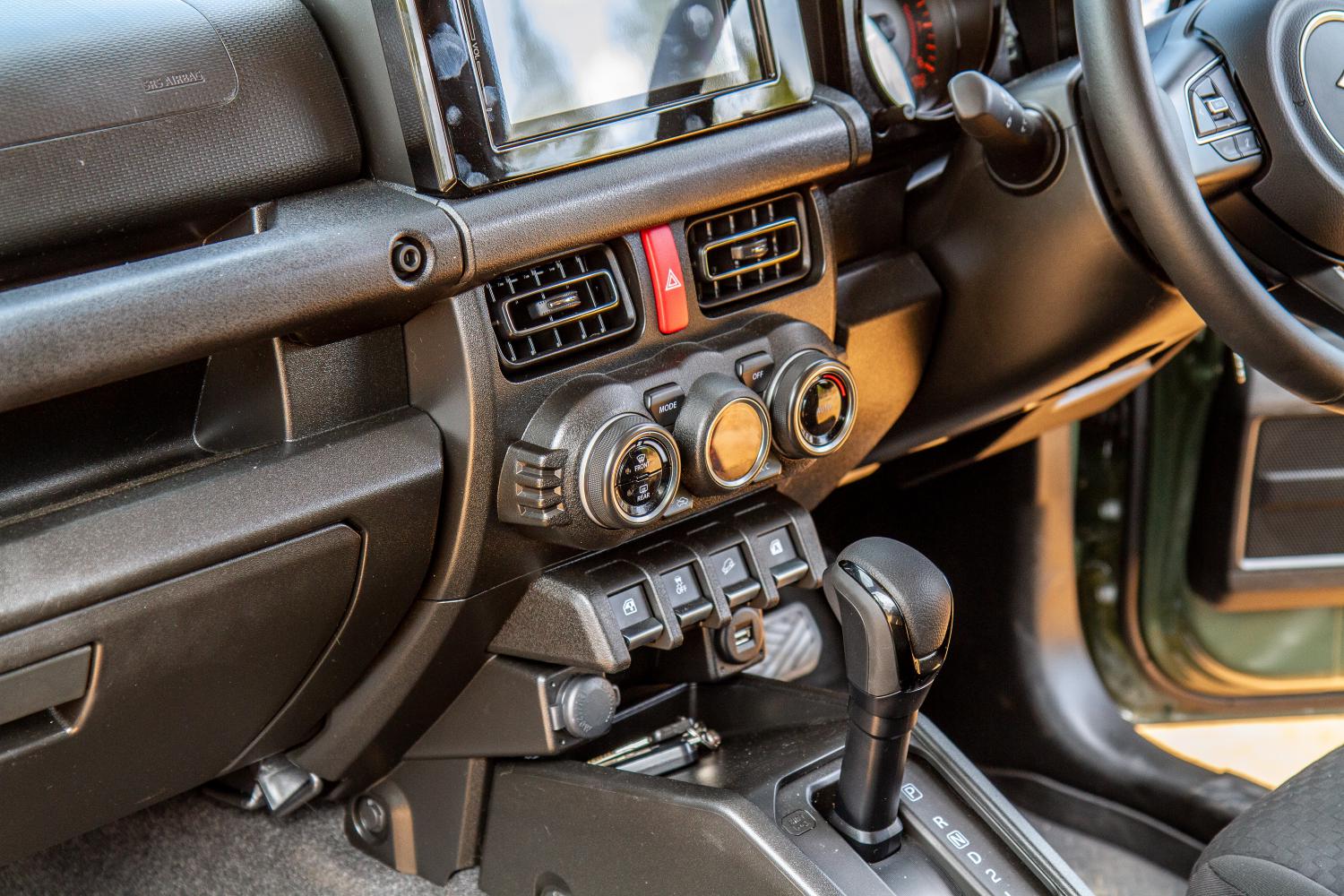
One of the most chilling 4WD moments that’s burned into my brain was around a decade ago when I watched a bunch of youngsters in a solid axle Sierra teetering on two wheels as they took a corner too quickly in suburban Adelaide. It was only by pure luck that the driver steered right instead of left to put it back on its wheels. With no rollover protection (ROPS) the result for this ragtop would have been tragic. They were laughing after the event, but that’s because they would have had no idea of the repercussions if it had gone tits-up.
The new Jimny steers nicely on the straight and on gentle bends despite the crap highway tyres fitted (195/80R15), but push it hard into a corner, and it can be a bit of a pig, with plenty of understeer evident and the feeling that it will snap into an oversteer fishtail moment if you aren’t on the ball. That’s where VSC will help save the day.
My friends in the Sierra in that same death-defying moment would have firstly copped a decelerative moment as engine speed would have been trimmed, thus starting the slow-down process. Selective autonomous braking would have then tapped the right-hand front and then the left-hand rear as it transitioned from oversteer to understeer and forced it to steer straight to get the car back in shape.
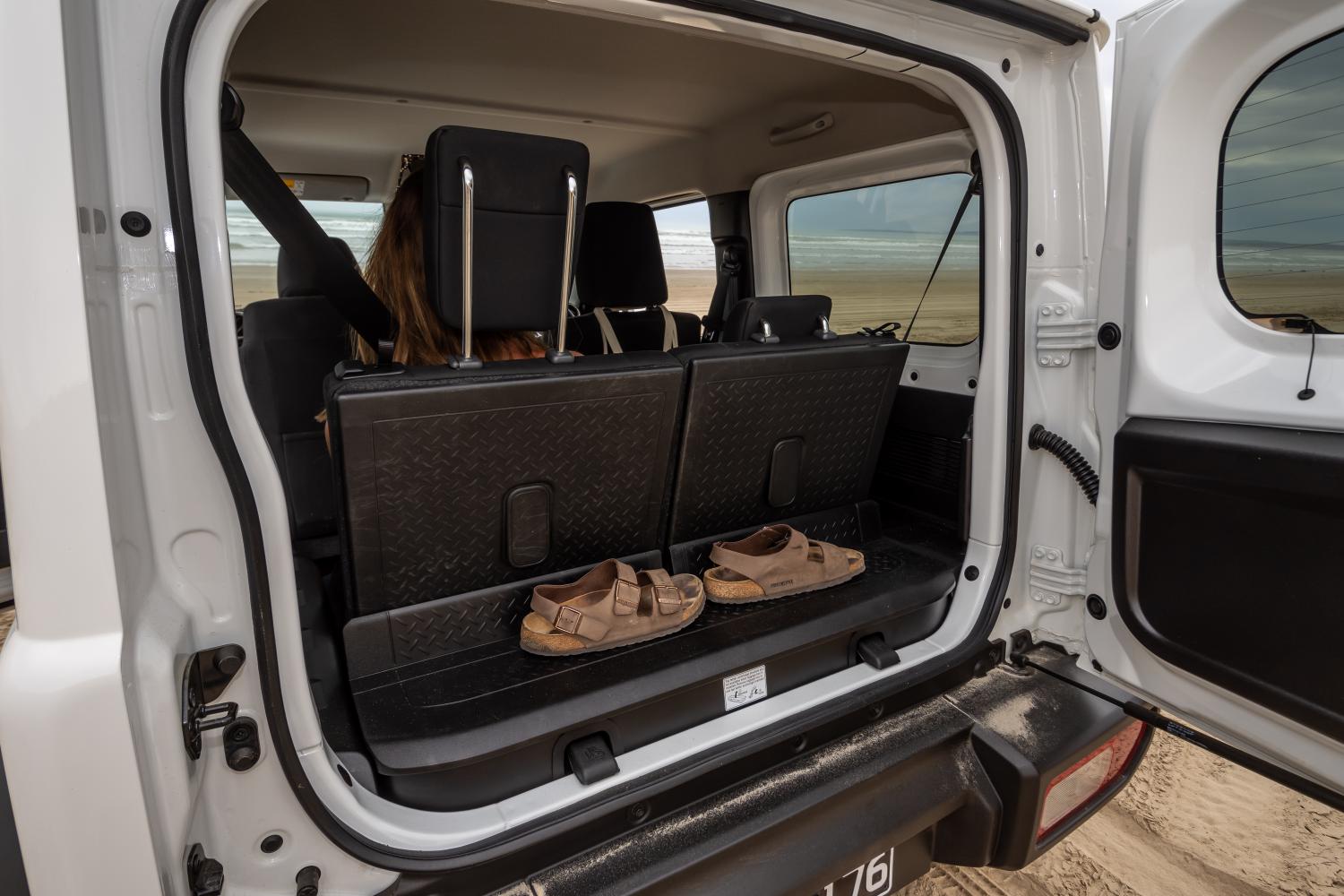
It does steer pretty well for a live-axle machine and a lot of that has to do with the fact that it runs electric power steering. In big winds you’ll be doing some correcting and on some bumpy bitumen it gets the fidgets, but I reckon a change in rubber would make all the difference. I know a couple of guys running LT235/75R15 Toyo OPAT2 rubber and fitted to CSA’s Ranger steelies on their Jims and they reckon that combo fixes stability at all speeds.
Now my testing included both an auto and a manual Jimny and I managed to get a ‘wombat test’ done with the auto. On a decent bit of bitumen at 80km/h, I chucked it right, and stability started tickling the brakes and then left before I sensed the engine speed getting trimmed. Mind you this is all pretty hard to measure precisely because it’s happening in fractions of a second, but there was a difference. Was it pretty? No. There was plenty of body roll, and the tyres were complaining, but it worked, so I suppose you can have your cake and eat it.
Having your cake means Jimny is an ace off-road, but an imperfect ace!
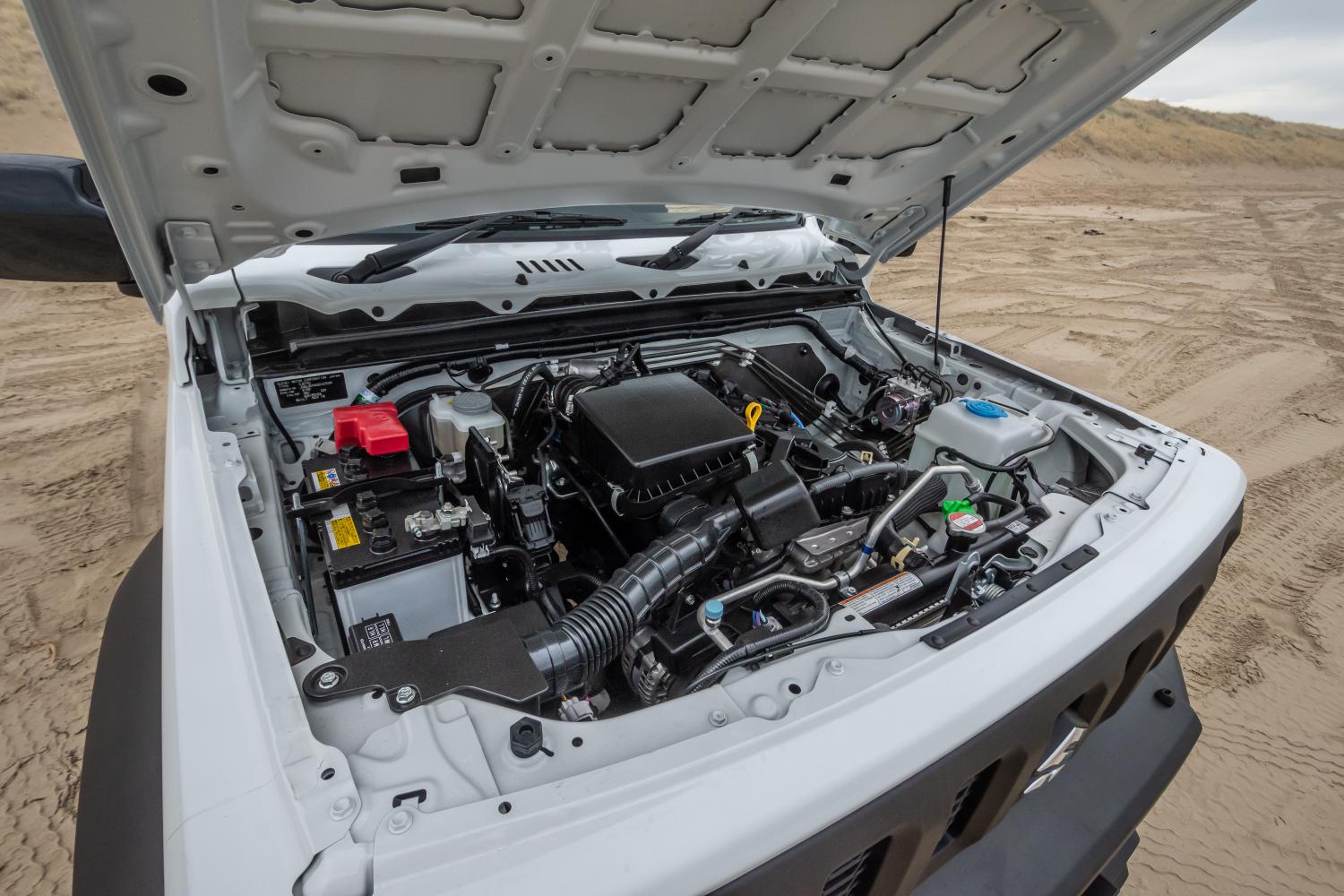
That same suspension set-up affords excellent articulation, but the spring rate is too soft. I had more than a few times where the front springs weren’t able to control a suburban speed hump, let alone an erosion gutter up at Adventure HQ without crashing to the bump stops. With no passengers in the back, the back end didn’t suffer the same malady, but with me sitting in there at 90kgs, it was a different story.
The 4WD driveline is a basic (and that’s good) part-time system offering three modes, 2WD high range for the blacktop, 4WD high range for dirt roads and hard beaches and 4WD low range for the steep and boggy stuff. High range 2WD and 4WD can be engaged at speeds up to 100km/h (but don’t do that thank you, 80km/h is safer on dirt) and low range can only be selected when the vehicle is stationary and in neutral.
Joy upon joy! A traditional transfer lever has made its return, as that was a sticking point with the old model, the push button arrangement was crap.
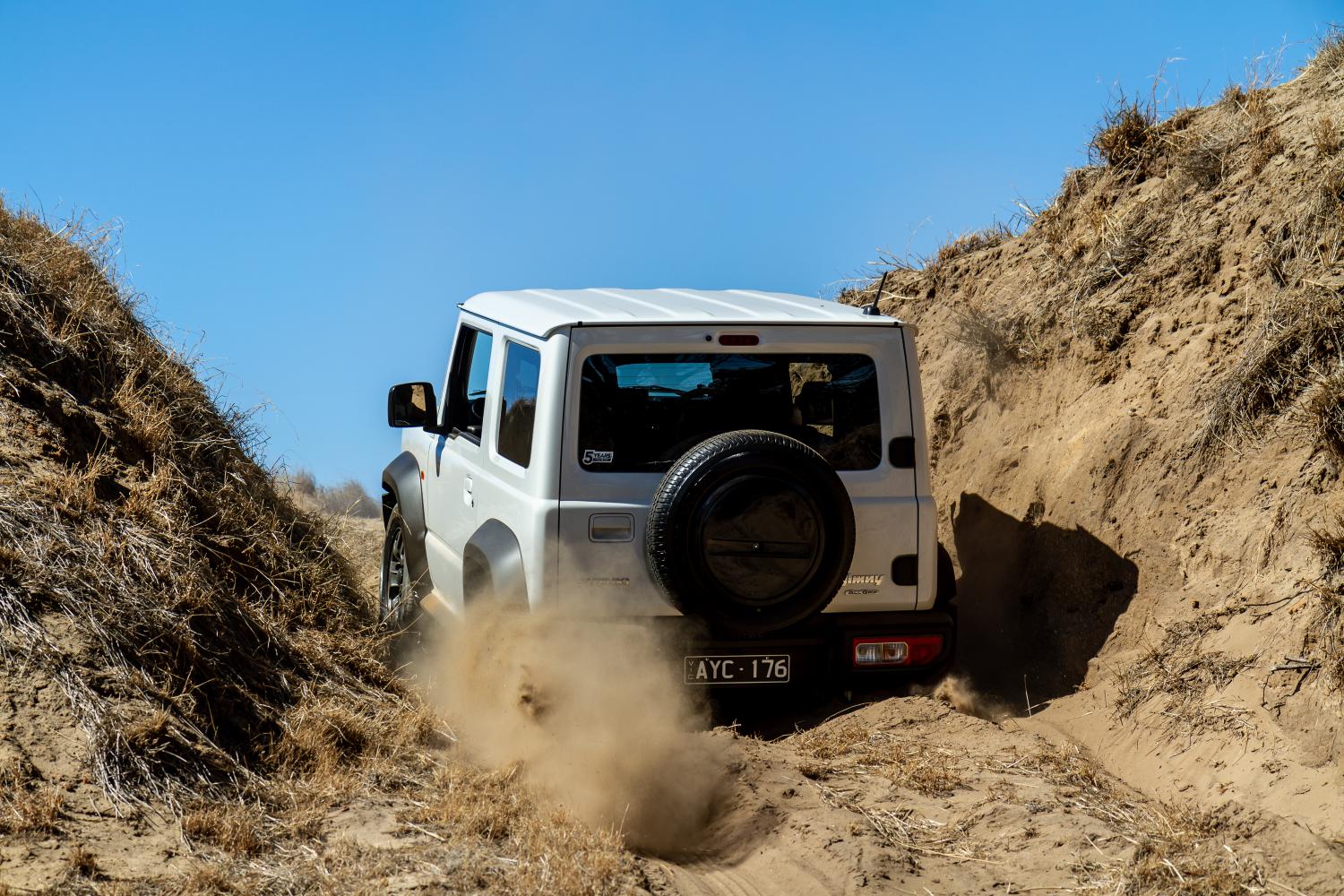
Watching the Jim clamber up and over the obstacles that we put in its way was revealing; man this car has some flex in it stock standard! We’re used to seeing an inflexible front end on most 4X4s thanks to IFS, and it was great to see the Jimny walk through obstacles, instead of kicking up a wheel in the air.
The new Jim uses traction control as they all do, but at least this one is tuned for early action. I haven’t asked the question of Suzuki, but I suspect their algorithm thingies are tuned in two ways, one to recognise high range usage and one for low. On hard surfaces in low range, the system worked pretty well and would put a few larger 4X4s I drive in the course of my local training business to shame. Not bad for a circa $30K vehicle, but traction control is still shite on sand, even in a Jimny.
We took both vehicles down along Goolwa Beach to the Murray Mouth to check their sand capability. The previous generation Jimny was a demon in the sand, and we wanted to know if the new one upheld the tradition and found that it would, if traction control didn’t get in the way.
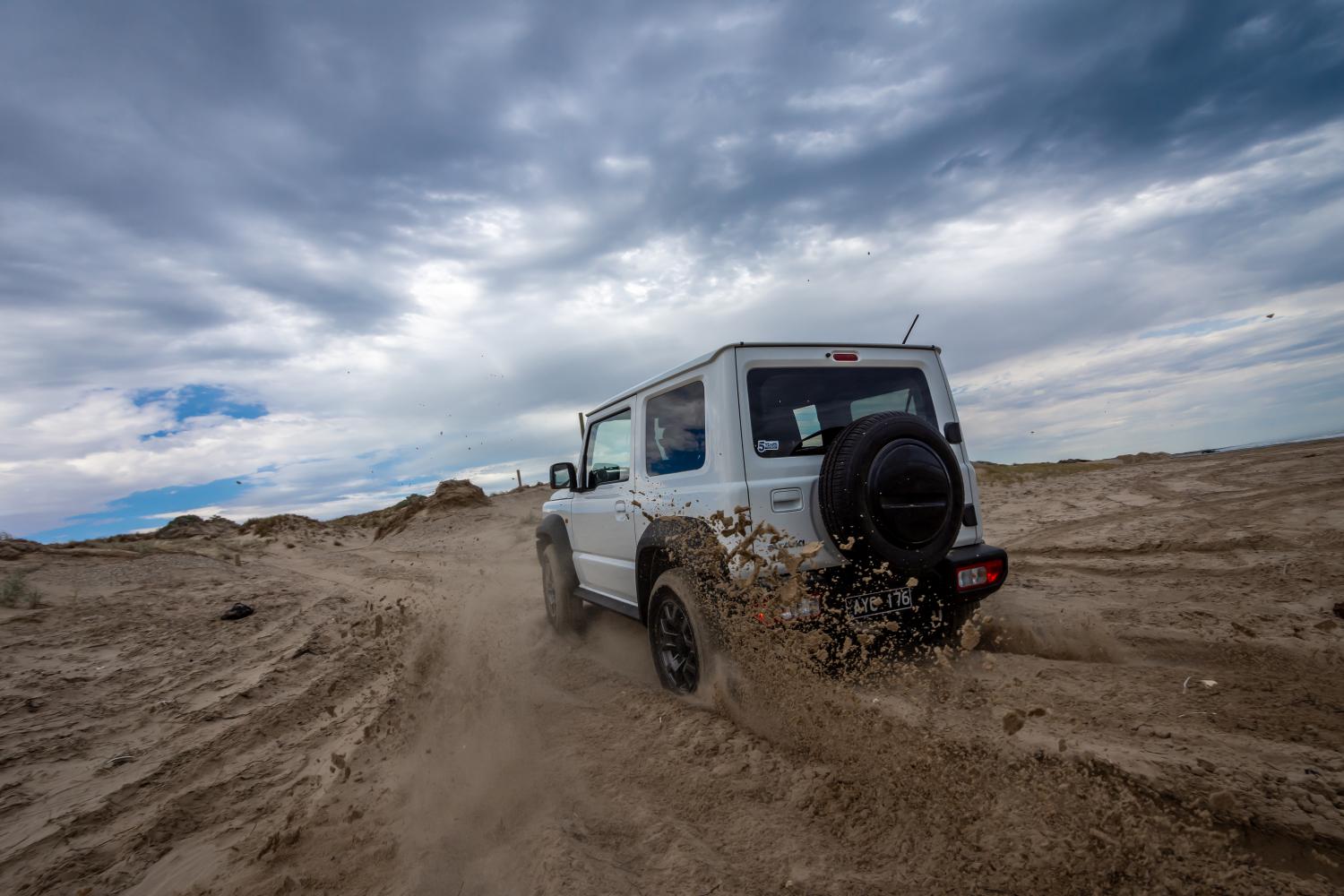
Having open diffs front and rear works provided you can maintain traction, but if a wheel goes light look out! That wheelspin sucks all of the torque going to that axle pairing out through the lifted wheel and stops the vehicle. If you keep pressing on the go-pedal, it will transition to diagonal wheelspin and dig a big hole. That’s the open-diff effect. Get off the gas, and you’ll keep mobile, because wheelspin is your nemesis off-road.
Traction control on the Jimny can be turned off via the VSC button, but go any faster than 30km/h, and it’ll go back to default and turn on again. The speed threshold is too low, and when I push a button to turn something off, I want it to stay off. That needs addressing, and I bet it’s just a software tweak.
One way to address the grip levels would have been to have offered standard, or option-in a locking rear differential. With the back axle locked, it would mitigate most issues of imperfect grip and lessen the need for traction control to be bothered. ARB and others can sort that out for you, and it’ll make the Jimny a whole lot more capable off-road.
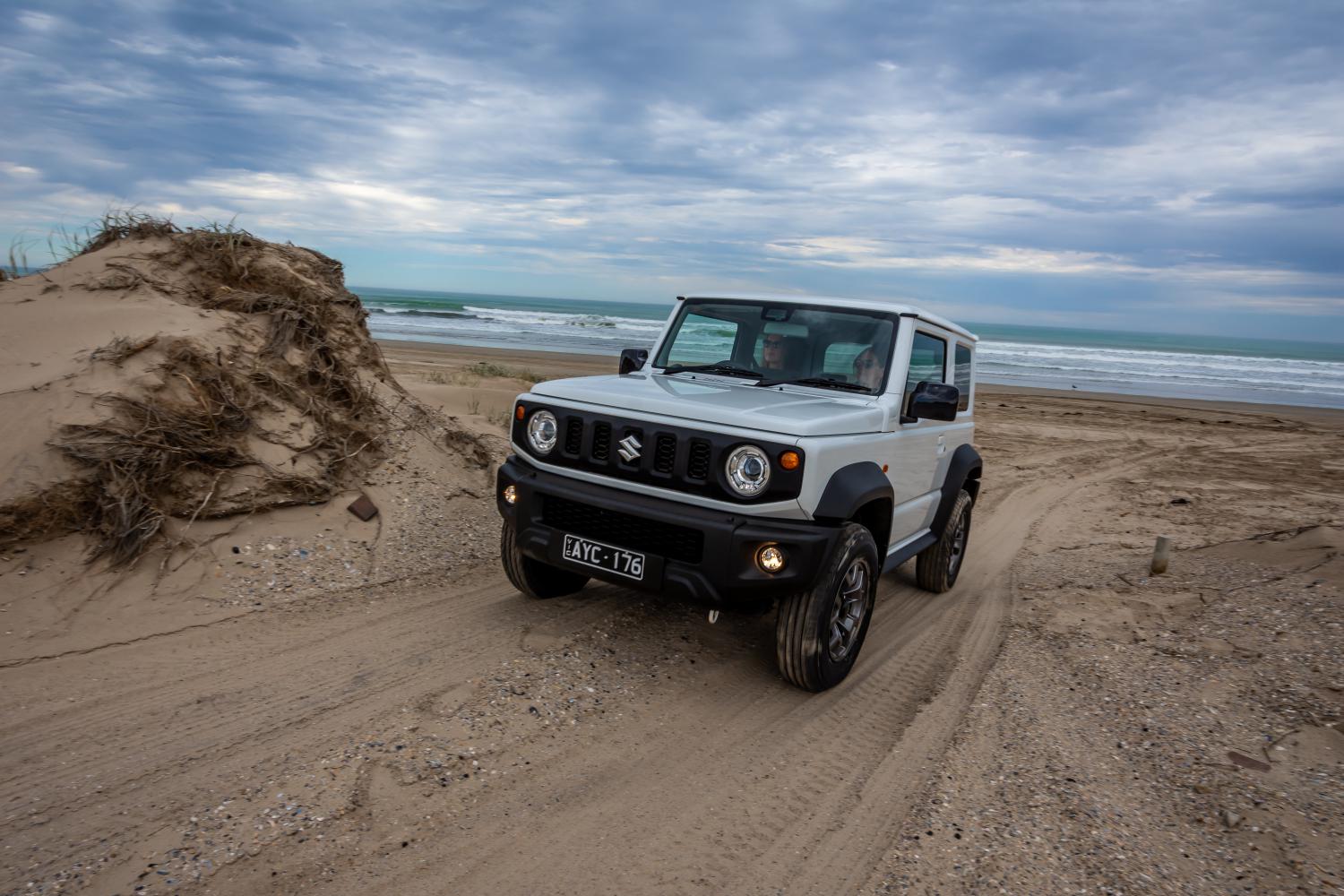
Which transmission is best? This is a super tricky question, and the best answer I can give you is this. The automatic is better off-road, no question on that. A manual with a petrol motor and only 130Nm of torque, delivered at a peaky 4,000rpm, means you have to flog it hard to keep moving. Being used to diesels, I stalled the Jimny more than a few times when trying to negotiate rugged country at slow engine speeds where finesse and torque were required. The auto, on the other hand, lets the torque converter do the slipping, saves the left foot and keeps the Jimny rolling.
The problem with the auto is that it’s an old three-speed with an overdrive fourth, which is at least a gear short of what it needs. It also lacks a sports-shift to make a semi-automatic out of it. As it stands, the auto sucks the soul out of what is a zingy little motor with the manual behind it, whereas a five-speed auto would have helped mask the torque deficit and provide livelier performance.
The manual’s not much better, five-speeds are uncommon now, and six was what was needed. At 110km/h the manual Jimny’s engine is spinning at around 3,000rpm, and that could make light work of the little 40-litre fuel tank, pushing what is a little block of flats through the air. Fifth in the manual is direct drive, which is why the manual is such a hoot to drive around an urban environment, but it needs an overdrive sixth for highway running.
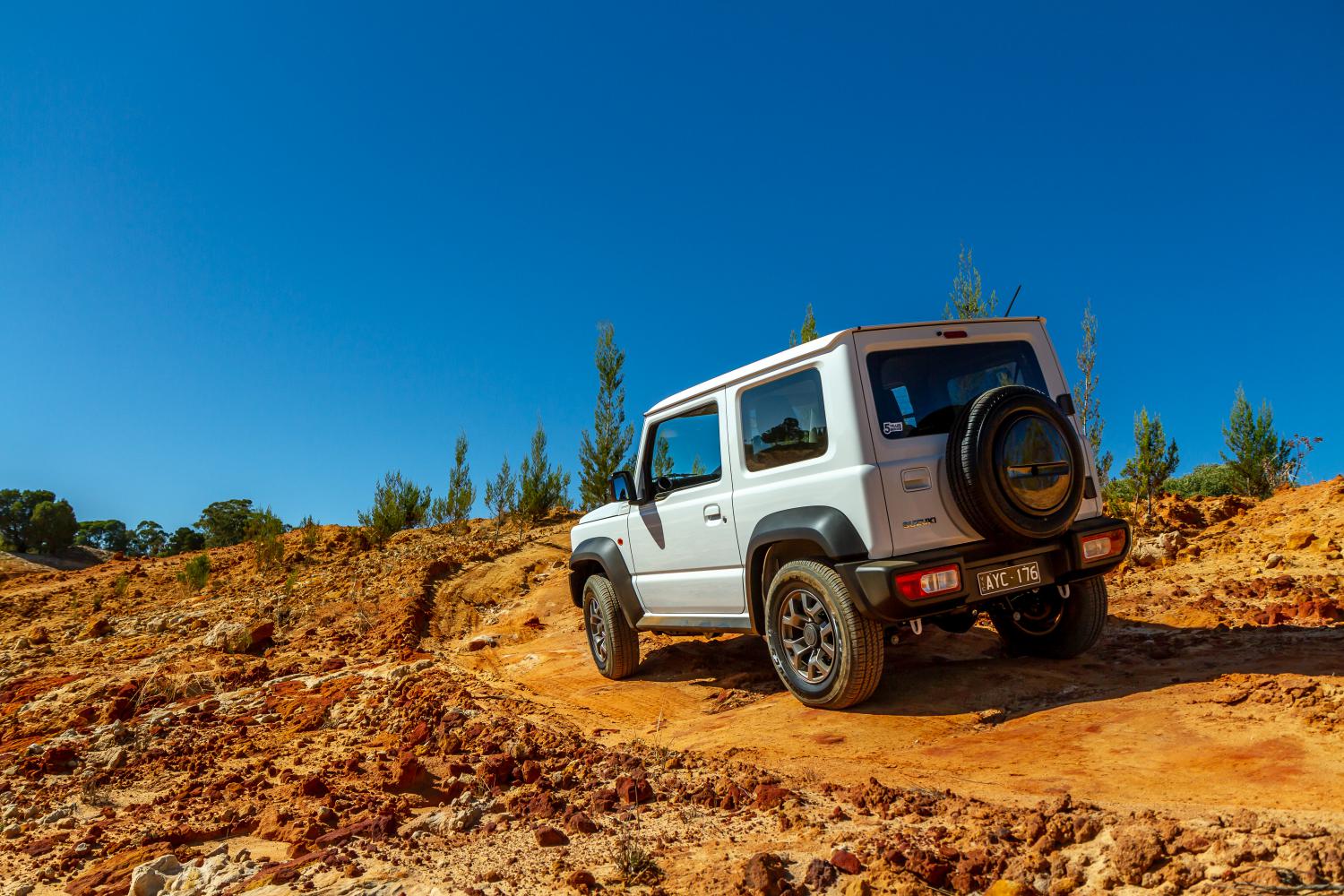
Is the new Jimny better than the old one? The answer is, of course, a resounding yes, but not without waving a red flag or two. The 1.5-litre petrol four has a lot more punch than the previous 1.3-litre. The ergonomics are better, and it’s a comfy place to be with more elbow room even if you’re approaching two metres tall. It’s got everything I hold dear in a proper 4WD and more because it’s got a chassis with coil springs, a perfect footprint, good clearance at 210mm, excellent off-roading angles and weighs bugger-all at 1,095kgs with the manual gearbox and 1,110kgs in auto guise. The addition of safety tech is always welcome.
The negatives are a payload that’ll only accommodate a bum in each seat, 340kgs (manual) and 325kgs (auto). That tells me that after you fit a bull bar, a larger fuel tank, some lights, a fridge and food, clothes and some recovery gear along with a set of decent Light Truck tyres you might be struggling to legally carry a passenger.
The rear brakes are drums when a drum-in-disc arrangement would have been better to get the best stopping/handbrake arrangement coupled to reduced servicing. Drums are junk. You should be able to switch the traction control off and have it stay off, and it needs more gears in both auto and manual form.
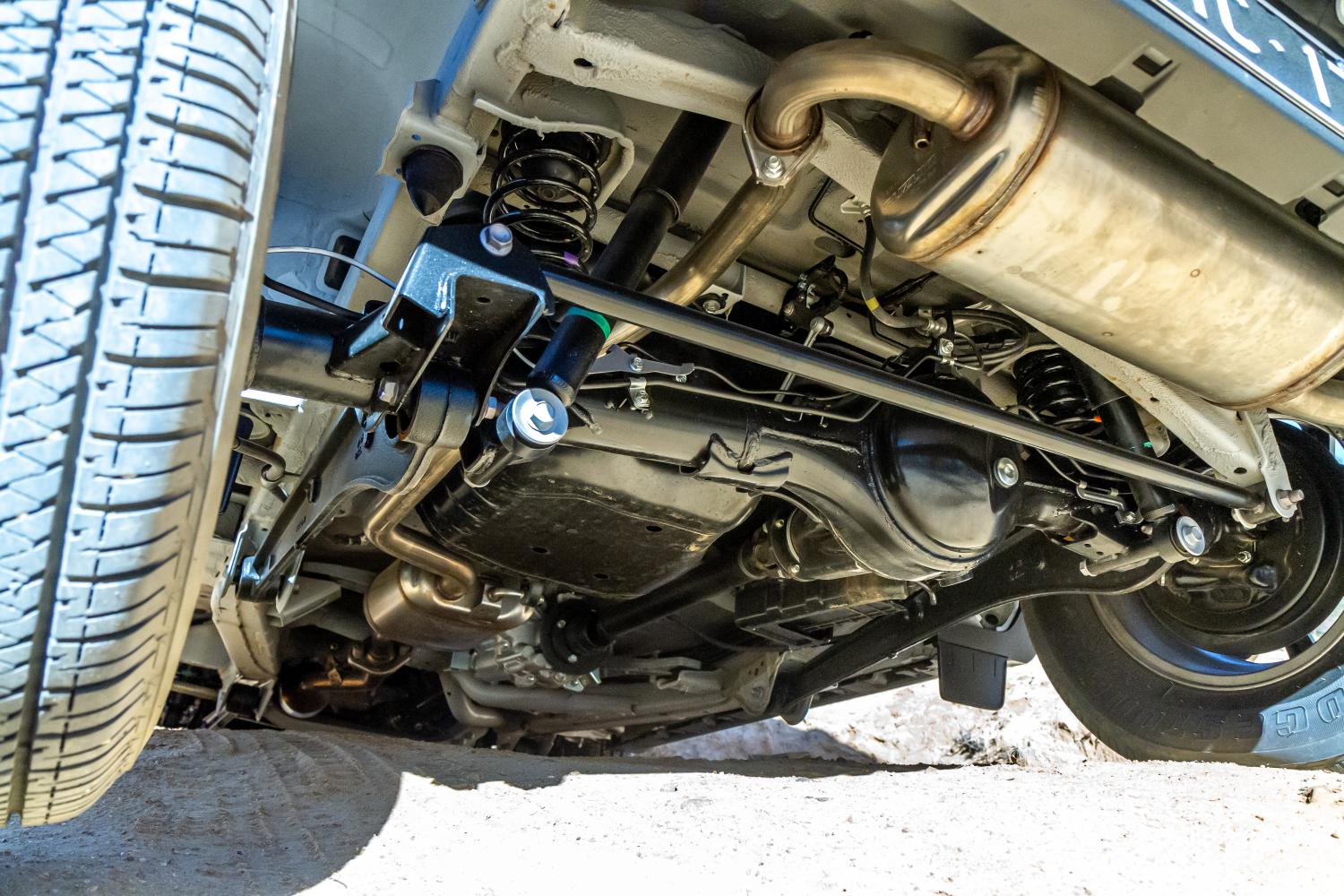
But those issues don’t stop the Jimny being the most fun we’ve had on four wheels in a very long time. It’s an endearing drive, one loaded with character and smile-inducing involvement. It’s a 4X4 that you want to own, regardless of its shortcomings and one, once experienced, isn’t easily forgotten. It’s a real 4X4 in a world of pretenders.
The new world of auto design is as boring as batshit, and the Jimny isn’t. I haven’t completely fallen for a new vehicle in ages, but this one has me smitten!
Footnote
I’d like to imagine it upsized, with two more doors, and I might just get my wish in 2023, because word is out that Jimny will have a bigger brother.
That same word suggests that to meet emissions standards in Europe, the vehicle will have to be a mild hybrid. That’s a combination that would find plenty of traction in Australia and the technology already exists in Suzuki’s catalogue. We’ll report on that when news comes to hand.
But Wait, There’s More…
CSA Ridgeline – NEW Suzuki Jimny Fitment
I’m smitten with the JB74 Suzuki Jimny, a vehicle that despite its tiny size is absolutely huge on fun and [...]
Sizing It Up – CSA Raptor v MR Triton
The CSA Raptor wheels have been on the MitsiMates Triton for over 6 months now, and we’re still feeling the [...]
Matty Hill Chooses The Konig Hypergram
We’re excited! Our Konig Hypergram flow formed wheels have recently had their debut under Matty Hill’s S15 drift car monster [...]
2022 Isuzu D-MAX LS-U+ Review
I can still remember the first current generation D-MAX I drove. It was winter in 2020 (I think) and we’d [...]
2023 Next-Gen Ranger By ARB
Built for touring, this ARB Next-Gen Ranger build showcases the breadth of products that the off-road brand has created for [...]
2023 Next-Gen Everest By ARB
We all know that the right wheels are an integral component of any serious vehicle build, and this Ford Everest, [...]
You know, there are precious-few 4WDs that I’ll acknowledge as I’m driving around. It’s a sea of blandness. All the Thai-built Japanese 4WD wagons are going down the same path of ever-increasing ugliness, their makers trying to outdo one another in making snazzy angular LED headlight/DRL treatments, others are just dumbing theirs down to meet the expectations of the urban ninety-percenters. It’s enough to drive a bloke to drink.
However one manufacturer has poked a stick in the eye of the “Transformer” stylists and gone back to its roots and builds a compact wagon that I reckon is just the duck’s guts. It’s not perfect, but every time I see one I’ll pay attention.
It’s the Suzuki Jimny.
I reckon it was a ballsy move, when whoever the brave Suzuki executive who proposed a Kermit-green square box on wheels, should be the next-gen JB74 Jimny and succeeded in convincing a board of directors that it would sell. Sell it has. Like hotcakes infused with something illicit. The “drugs” that Jimny brings to the table are styling cues that scream sensible, basically two boxes, and a capability that all the pretenders can’t match.
Let’s talk about those boxes.

The shape is perfect for a 4WD. Those slab sides equate to internal volume, with an absence of tapering roof lines to impinge on carrying capacity internally; incredibly important when it’s a micro-4WD. Helping maximise useable space is a rear folding seat arrangement that’ll lay flat. I had a look at the mounting system for the back seats, and it wouldn’t take much to remove them and increase the depth of the cargo area even more if the seat/seatbelt sensors could be unplugged.
I found the driving position to be spot on, the seat base height okay and fore/aft movement enough to offer my six-foot frame a very comfy reach to the pedals and the steering wheel. The steering wheel is adjustable, so if you’re carrying a bit of belly, you’ll still be able to sneak it in under the wheel’s rim. The seats were comfortable with decent support, and my bum remained numb-free after three hours.
Two big blokes would be touching shoulders in the old Jimny’s cab. This one’s noticeably wider, but I reckon there’s a market for one a little larger again and with four doors for a better payload.
The new two-door Jimny measures 3,645mm long and 1,645mm wide, which is compact. Combine that small footprint with the excellent visibility afforded by the Jimny’s squared off corners and upright windscreen, and you have the perfect ‘around town’ vehicle.

Throwbacks to days of old are everywhere. It has a key, not one of those idiotic push-button starts with a dopey transponder to go wrong. I love the fact that it has roof gutters and not the flimsy plastic roof rails seen on the old model. That will make a roof-rack an easy-peasy install. It’s also got round, yes round, LED headlights and they work, because the lens isn’t some funky angular thing, they have a nice deep reflector that projects a beam down the road. What I didn’t like so much, was the oncoming or ambient light sensor that made switching to high beam impossible around town even when there was nobody around.
While the Jimny remains true to its roots, it’s now packing a larger electronic arsenal and several concessions to modernity.
Right slap bang in the middle of the dash is a telly. Jimny has joined the touch screen infotainment revolution, and this one is a pretty good thing with hook-ups to Apple CarPlay and Android Auto via a USB outlet. Bluetooth was quick to capture my phone and get me chatting, or you can plug your phone in via a USB outlet and use The sound was fine for my analogue ears on the AM stations and Georgia our resident ‘bright young thing’ (BYT) and road tester thought the sound was good enough to satisfy most people’s curiosity. There’s a couple of 12V outlets, and the reversing camera was clear and easy to use.
Electric windows and mirrors you’ll find, and an air conditioning system, that despite the glasshouse effect of the cab, managed to deal with a couple of stinking hot Adelaide days.
The interior is carpeted and likes to trap sand, making the clean-up a frustrating exercise. I’d like to see vinyl in there, but hey, it’d likely be fixed with some decent rubber mats. The carpet mats sitting atop the carpeted floor will cop a hammering, so my advice would be to seek out some aftermarket sculpted rubber versions and do it early in your ownership, because old carpet looks like shite.

Additionally, the plastic surfaces, dash, door cards and rear seat backs are a hard composition and will scratch easily. For the sake of my old right elbow, a door card with a hint of forgiveness would have been nice for windowsill resting, and the left one is left dangling as there’s no centre console cubby-box, merely a couple of drink holders set low behind the handbrake.
Below the central air vents and A/C controls are the buttons for some of the selectable driver aids and safety kit now standard in Jimny, including traction/vehicle stability control (TRC/VSC) and hill descent control (HDC). Suzuki calls its traction control system ‘Brake LSD’, which is a curious description because it bears no resemblance to a slippery diff in the way it works.
It’s even got lane departure (LDW), lane weave (LW) and forward autonomous braking (FAB) hooked up to anti-lock brakes (ABS) and hill-hold (HH), all of which is a serious departure from what was found in previous Jimnys.
Despite my indignation at these concessions to modernity, I’ll have to pull my safety hat on a little tighter, as they’re necessary, not only to move with the times but also to mitigate the new Jimny’s on-road flaw, which is safety at speed. Suzuki’s solid axle Jimny isn’t as safe at high speed as vehicles with independent suspension, either up-front or all round. It’s one of the reasons most manufacturers have moved away from this type of suspension.

One of the most chilling 4WD moments that’s burned into my brain was around a decade ago when I watched a bunch of youngsters in a solid axle Sierra teetering on two wheels as they took a corner too quickly in suburban Adelaide. It was only by pure luck that the driver steered right instead of left to put it back on its wheels. With no rollover protection (ROPS) the result for this ragtop would have been tragic. They were laughing after the event, but that’s because they would have had no idea of the repercussions if it had gone tits-up.
The new Jimny steers nicely on the straight and on gentle bends despite the crap highway tyres fitted (195/80R15), but push it hard into a corner, and it can be a bit of a pig, with plenty of understeer evident and the feeling that it will snap into an oversteer fishtail moment if you aren’t on the ball. That’s where VSC will help save the day.
My friends in the Sierra in that same death-defying moment would have firstly copped a decelerative moment as engine speed would have been trimmed, thus starting the slow-down process. Selective autonomous braking would have then tapped the right-hand front and then the left-hand rear as it transitioned from oversteer to understeer and forced it to steer straight to get the car back in shape.

It does steer pretty well for a live-axle machine and a lot of that has to do with the fact that it runs electric power steering. In big winds you’ll be doing some correcting and on some bumpy bitumen it gets the fidgets, but I reckon a change in rubber would make all the difference. I know a couple of guys running LT235/75R15 Toyo OPAT2 rubber and fitted to CSA’s Ranger steelies on their Jims and they reckon that combo fixes stability at all speeds.
Now my testing included both an auto and a manual Jimny and I managed to get a ‘wombat test’ done with the auto. On a decent bit of bitumen at 80km/h, I chucked it right, and stability started tickling the brakes and then left before I sensed the engine speed getting trimmed. Mind you this is all pretty hard to measure precisely because it’s happening in fractions of a second, but there was a difference. Was it pretty? No. There was plenty of body roll, and the tyres were complaining, but it worked, so I suppose you can have your cake and eat it.
Having your cake means Jimny is an ace off-road, but an imperfect ace!

That same suspension set-up affords excellent articulation, but the spring rate is too soft. I had more than a few times where the front springs weren’t able to control a suburban speed hump, let alone an erosion gutter up at Adventure HQ without crashing to the bump stops. With no passengers in the back, the back end didn’t suffer the same malady, but with me sitting in there at 90kgs, it was a different story.
The 4WD driveline is a basic (and that’s good) part-time system offering three modes, 2WD high range for the blacktop, 4WD high range for dirt roads and hard beaches and 4WD low range for the steep and boggy stuff. High range 2WD and 4WD can be engaged at speeds up to 100km/h (but don’t do that thank you, 80km/h is safer on dirt) and low range can only be selected when the vehicle is stationary and in neutral.
Joy upon joy! A traditional transfer lever has made its return, as that was a sticking point with the old model, the push button arrangement was crap.

Watching the Jim clamber up and over the obstacles that we put in its way was revealing; man this car has some flex in it stock standard! We’re used to seeing an inflexible front end on most 4X4s thanks to IFS, and it was great to see the Jimny walk through obstacles, instead of kicking up a wheel in the air.
The new Jim uses traction control as they all do, but at least this one is tuned for early action. I haven’t asked the question of Suzuki, but I suspect their algorithm thingies are tuned in two ways, one to recognise high range usage and one for low. On hard surfaces in low range, the system worked pretty well and would put a few larger 4X4s I drive in the course of my local training business to shame. Not bad for a circa $30K vehicle, but traction control is still shite on sand, even in a Jimny.
We took both vehicles down along Goolwa Beach to the Murray Mouth to check their sand capability. The previous generation Jimny was a demon in the sand, and we wanted to know if the new one upheld the tradition and found that it would, if traction control didn’t get in the way.

Having open diffs front and rear works provided you can maintain traction, but if a wheel goes light look out! That wheelspin sucks all of the torque going to that axle pairing out through the lifted wheel and stops the vehicle. If you keep pressing on the go-pedal, it will transition to diagonal wheelspin and dig a big hole. That’s the open-diff effect. Get off the gas, and you’ll keep mobile, because wheelspin is your nemesis off-road.
Traction control on the Jimny can be turned off via the VSC button, but go any faster than 30km/h, and it’ll go back to default and turn on again. The speed threshold is too low, and when I push a button to turn something off, I want it to stay off. That needs addressing, and I bet it’s just a software tweak.
One way to address the grip levels would have been to have offered standard, or option-in a locking rear differential. With the back axle locked, it would mitigate most issues of imperfect grip and lessen the need for traction control to be bothered. ARB and others can sort that out for you, and it’ll make the Jimny a whole lot more capable off-road.

Which transmission is best? This is a super tricky question, and the best answer I can give you is this. The automatic is better off-road, no question on that. A manual with a petrol motor and only 130Nm of torque, delivered at a peaky 4,000rpm, means you have to flog it hard to keep moving. Being used to diesels, I stalled the Jimny more than a few times when trying to negotiate rugged country at slow engine speeds where finesse and torque were required. The auto, on the other hand, lets the torque converter do the slipping, saves the left foot and keeps the Jimny rolling.
The problem with the auto is that it’s an old three-speed with an overdrive fourth, which is at least a gear short of what it needs. It also lacks a sports-shift to make a semi-automatic out of it. As it stands, the auto sucks the soul out of what is a zingy little motor with the manual behind it, whereas a five-speed auto would have helped mask the torque deficit and provide livelier performance.
The manual’s not much better, five-speeds are uncommon now, and six was what was needed. At 110km/h the manual Jimny’s engine is spinning at around 3,000rpm, and that could make light work of the little 40-litre fuel tank, pushing what is a little block of flats through the air. Fifth in the manual is direct drive, which is why the manual is such a hoot to drive around an urban environment, but it needs an overdrive sixth for highway running.

Is the new Jimny better than the old one? The answer is, of course, a resounding yes, but not without waving a red flag or two. The 1.5-litre petrol four has a lot more punch than the previous 1.3-litre. The ergonomics are better, and it’s a comfy place to be with more elbow room even if you’re approaching two metres tall. It’s got everything I hold dear in a proper 4WD and more because it’s got a chassis with coil springs, a perfect footprint, good clearance at 210mm, excellent off-roading angles and weighs bugger-all at 1,095kgs with the manual gearbox and 1,110kgs in auto guise. The addition of safety tech is always welcome.
The negatives are a payload that’ll only accommodate a bum in each seat, 340kgs (manual) and 325kgs (auto). That tells me that after you fit a bull bar, a larger fuel tank, some lights, a fridge and food, clothes and some recovery gear along with a set of decent Light Truck tyres you might be struggling to legally carry a passenger.
The rear brakes are drums when a drum-in-disc arrangement would have been better to get the best stopping/handbrake arrangement coupled to reduced servicing. Drums are junk. You should be able to switch the traction control off and have it stay off, and it needs more gears in both auto and manual form.

But those issues don’t stop the Jimny being the most fun we’ve had on four wheels in a very long time. It’s an endearing drive, one loaded with character and smile-inducing involvement. It’s a 4X4 that you want to own, regardless of its shortcomings and one, once experienced, isn’t easily forgotten. It’s a real 4X4 in a world of pretenders.
The new world of auto design is as boring as batshit, and the Jimny isn’t. I haven’t completely fallen for a new vehicle in ages, but this one has me smitten!
Footnote
I’d like to imagine it upsized, with two more doors, and I might just get my wish in 2023, because word is out that Jimny will have a bigger brother.
That same word suggests that to meet emissions standards in Europe, the vehicle will have to be a mild hybrid. That’s a combination that would find plenty of traction in Australia and the technology already exists in Suzuki’s catalogue. We’ll report on that when news comes to hand.
But Wait, There’s More…
CSA Ridgeline – NEW Suzuki Jimny Fitment
I’m smitten with the JB74 Suzuki Jimny, a vehicle that despite its tiny size is absolutely huge on fun and [...]
Sizing It Up – CSA Raptor v MR Triton
The CSA Raptor wheels have been on the MitsiMates Triton for over 6 months now, and we’re still feeling the [...]
Matty Hill Chooses The Konig Hypergram
We’re excited! Our Konig Hypergram flow formed wheels have recently had their debut under Matty Hill’s S15 drift car monster [...]

